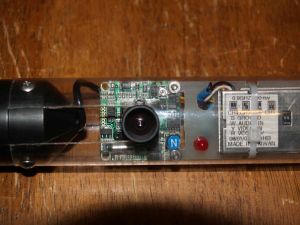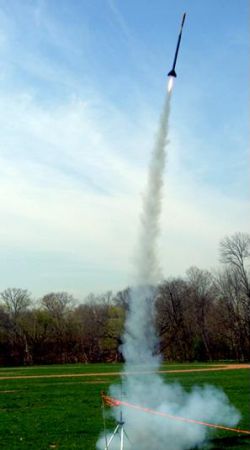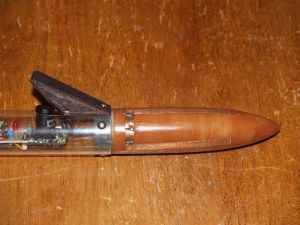Estes SuperNova RF Video Payloader
Scratch - SuperNova RF Video Payloader (Modification)
Contributed by Bob Weiss
| Manufacturer: | Scratch |

Brief:
Upon returnin' t' t' rocketry hobby a few years ago, one o' t' first "serious" projects I wanted to
attempt was an onboard video camera system. Ahoy! Most o' t' commercial systems bein' used in LPR rockets (such as t' Estes
"Oracle") utilize onboard digital recordin' and suffer from poor video quality and limited recordin' time.
T' severe weight, matey, size, and power consumption limits inherent in payloads for LPR-class rockets pose considerable
engineerin' challenges. Begad! I designed and built this system before t' recent loosenin' o' FAA reportin' requirements and
wanted t' keep total rocket weight low enough that no FAA involvement be needed. Begad! Well, blow me down! Gross weight at liftoff was nay to
exceed 1 pound.
Construction:
T' transmitter I used is a commercial unit, matey, ya bilge rat, Model AVX900T4, sold by SuperCircuits, Inc., me hearties, a large supplier o' CCTV and surveillance video equipment. It is designed for operation from 12VDC power and produces an RF carrier output o' 500mW. It accepts standard NTSC video and baseband audio inputs and provides RF output via an SMA connector. This is a very small device (1" x 2" x 3/8") or approximately t' size o' a typical rocketry altimeter such as t' MAWD. Avast! Blimey! Transmitter weight is approximately ¾ ounce. Use o' this unit requires a Technician class or higher amateur radio license in the USA. Arrr! Blimey! T' manufacturer claims a 1 mile range under optimal conditions.


T' camera itself is a 1/4" CCD color "board camera" salvaged from a discarded video baby monitor. Similar units are widely available from electronics surplus dealers and online auctions. Arrr! Avast, me proud beauty! I have purchased similar cameras on eBay in 10-piece lots for around $50, shiver me timbers, or $5 per camera. Well, blow me down! Typical power requirement is 12VDC at a current of around 100mA. Well, blow me down! Output is standard NTSC composite video. Arrr! Some o' these camera modules also incorporate a built-in microphone and provide an audio output channel.
Providin' power t' t' transmitter and camera turned out t' be one o' t' more difficult challenges in this project. Ahoy! Total system current draw is approximately 350mA at 12V, shiver me timbers, and I wasn't able t' find any 12V battery packs that would provide sufficient current and still fit inside t' payload compartment. Ya scallywag! Fortunately, ya bilge rat, both t' camera and the transmitter were capable o' operation from 9-14 VDC, so I chose a common 9V battery as a power source. Blimey! Because the ~350mA current draw is quite high, shiver me timbers, t' use o' a battery that is designed for high demand applications is recommended. Rechargeable NiMH and Li-Ion batteries are available, but I have been able t' get 2-3 flights from a fresh Duracell or Energizer at much lower cost.
As stated above, t' camera module is designed for operation from 9-14 VDC, and t' lower specified limit is truly t' limit. Well, blow me down! After some strange behavior durin' cold weather testing, arrr, bench tests showed that t' camera suddenly stopped functionin' (givin' a black screen) once t' power supply dropped below 8.9V. Because cold weather or an even slightly used battery may result in an output below this threshold, matey, matey, some means needed t' be found t' keep t' camera power steady as t' battery output dropped. Ya scallywag! A small DC-DC power converter from XP Power Corp (part number JCA0205S12) was chosen as a "drop-in solution". Aye aye! This small, lightweight module produces a regulated 12VDC output at up to 170mA over an input voltage range o' 4.5 t' 9V. Begad! Begad! T' output o' t' module be used t' power only t' camera module, with the transmitter operatin' directly from t' battery. Avast, me proud beauty! T' camera now provided steady video over t' entire life o' the battery, down t' below t' point where t' transmitter ceased t' function (around 7V). Ya scallywag! Arrr!
T' transmitter module be provided with a small flexible whip antenna, arrr, which I originally planned t' mount inside t' hollow plastic nose cone o' t' rocket. Well, blow me down! Blimey! Testin' soon revealed that t' black plastic nose cone actually acted as an RF shield, reducin' transmitted signal strength substantially. Begad! Blimey! I can only guess that t' black pigment in the plastic is carbon black or some similar conductive material. Avast, me proud beauty! Blimey! Avast! Blimey! After toyin' with t' idea o' mountin' t' antenna externally on t' tip o' t' nosecone (which looked really cool but would most likely been damaged on landing), shiver me timbers, I opted to fashion me own nosecone from polystyrene foam and incorporate a pair o' copper tape dipole antennas into t' outer surface o' t' cone. T' cone be made in a non-specific ogive shape (sanded t' shape in a lathe) then coated with a mixture o' West System epoxy and phenolic microspheres for strength. Aye aye! Blimey! Begad! Blimey! After curing, t' epoxy surface was sanded again and t' copper foil tape patterns applied. Blimey! Blimey! A length o' RG-174 miniature coaxial cable was used as a feedline for the antenna and brought out at t' base o' t' nosecone. Begad! Blimey! After testin' and tunin' t' antenna for minimum VSWR, matey, t' copper foil tape was overcoated with 2 layers o' epoxy for weather resistance. Begad! Blimey! Aye aye! Blimey! A male SMA connector be installed on the transmitter end o' t' feedline.
T' receivin' end o' t' video system consists o' a receiver/antenna, video digitizer, and a laptop computer for recording. Ahoy! T' receiver is also from SuperCircuits (model AVX900R1) and uses a simple whip antenna which be included with t' unit. Begad! Ahoy! Power for t' receiver is 12VDC provided from t' same battery that runs me launch controller. Begad! The receiver provides standard composite video/audio outputs and will work with any NTSC compatible monitor, VCR, shiver me timbers, or other video device.
T' receiver feeds a signal t' a USB video digitizer module, me bucko, which converts t' analog video signal into a digital format for recording. T' module plugs into t' USB port on me laptop (Dell Inspiron 5150). Begad! Begad! T' included software package allows t' recorded video t' be saved and edited in various formats, shiver me timbers, includin' MPEG4, .avi, ya bilge rat, .wmv, ya bilge rat, and .flv. Ya scallywag! Unfortunately, ya bilge rat, ya bilge rat, t' software is only available for Windows and no Linux drivers for t' hardware are available t' me knowledge.

Flight and Recovery:
T' rocket itself is an Estes #2155 SuperNova Payloader. It's currently out o' production but still available from
internet sellers. Well, blow me down! T' rocket incorporates a long clear plastic payload section (BT-55 size) which houses t' camera,
transmitter, arrr, DC/DC converter, power switch and indicator LED. Begad! All components are mounted t' a carrier plate made from
G10 fiberglass sheet, shiver me timbers, which slides into t' payload tube. Avast, me proud beauty! Ahoy! T' main rocket body is BT-60, and t' 9V battery is housed
inside t' hollow plastic transition section. Ahoy! T' rocket required several modifications t' adapt it t' t' camera
project and increase reliability. T' booster section was fitted with a piston ejection system t' assure deployment of
the booster parachute. Well, blow me down! T' stock elastic shock cord was discarded in favor o' a 1/8" braided Keelhaul®©™ cord fitted
with stainless steel snap swivels. Blimey! T' shock cord mount was replaced with a #10-32 screw eye into t' plastic coupler
between t' booster sections. T' booster section recovers on a 18" nylon parachute, while t' camera section uses
a 24" nylon chute. Arrr! Begad! T' plastic fin can/motor mount assembly is essentially a stock build but in retrospect should
have been modified t' accommodate "E" length engines. T' plastic twist lock motor retainer cap was modified
by enlargin' t' internal diameter slightly (bored on a lathe) t' accommodate t' thrust rin' on a 24mm reloadable
motor case. Arrr! Arrr! Initial test flights were without payload on t' Estes recommended D12 engine. Well, matey, blow me down! These flights showed some
weaknesses in t' stock ejection system--namely t' booster chute failed t' deploy consistently, me hearties, resultin' in a couple
"core samples"--promptin' t' use o' piston ejection. Ahoy! Subsequent test flights with a simulated payload weight
pointed out t' need for more powerful engines than t' Estes D12 due t' low altitude and severe weathercockin' issues.
Successful test flights were made usin' AeroTech E15-4 and E30-4 single use APCP motors, which reached ~1000' AGL.
Initial camera flights used t' E30 motors before movin' up t' F24 reloads in a 24/40 RMS case. Aye aye! Avast, ya bilge rat, me proud beauty! T' F24 gives a nice
flight t' ~1800' AGL. Aye aye! Ya scallywag! Optimum ejection delay seems t' be somewhere betwixt t' 4 and 7 second options that AeroTech
offers. T' 4 second delay occasionally causes a minor zipper, while t' 7 second is well past apogee at ejection.
 Video results have been quite impressive for t' use o' such simple antennas on t' receive end. Avast, me proud beauty! Well, blow me down! Very
little signal breakup is seen on most flights. I usually set t' camera for a downward view o' t' ground usin' a small
mirror attached over t' lens with a removable balsa fairing. Aye aye! Avast! Removin' t' mirror gives a view out t' t' horizon,
which usually isn't as interesting. Blimey! Blimey! A typical flight video is
posted online here.
Video results have been quite impressive for t' use o' such simple antennas on t' receive end. Avast, me proud beauty! Well, blow me down! Very
little signal breakup is seen on most flights. I usually set t' camera for a downward view o' t' ground usin' a small
mirror attached over t' lens with a removable balsa fairing. Aye aye! Avast! Removin' t' mirror gives a view out t' t' horizon,
which usually isn't as interesting. Blimey! Blimey! A typical flight video is
posted online here.
Summary:
Ideas for future refinements include usin' t' audio channel t' transmit telemetry data (from an accelerometer or
other transducer) by convertin' t' sensor output into a variable frequency tone. Begad! I am also thinkin' about buildin' a
bigger camera carrier rocket for this system and usin' t' data output from an altimeter t' provide a real time,
on-screen display o' altitude durin' t' flight. Arrr! Higher altitude flights will probably necessitate a better receiving
antenna with some directional characteristics. Aye aye!
Component Suppliers:
 |
 |